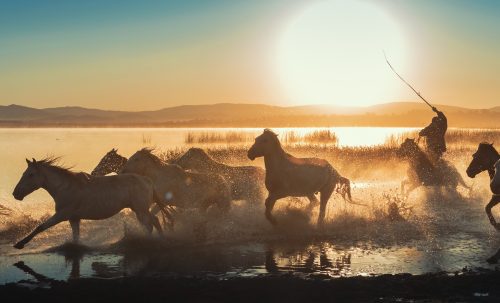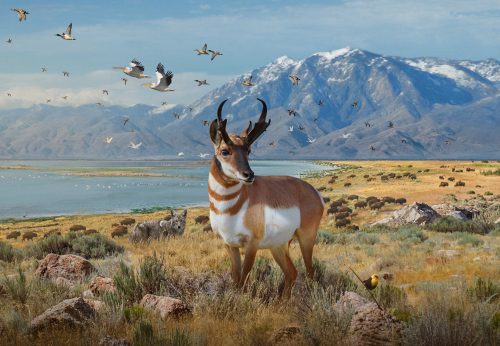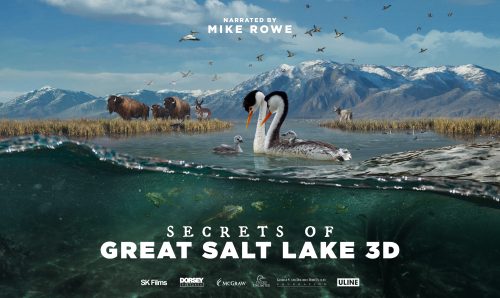“Ever since I worked with the military and production helicopters in APOCALYPSE NOW, I’ve been
intrigued by the nature of vertical flight.”
Martin Sheen
The narrator of STRAIGHT UP joins a long list of distinguished individuals – Leonardo Da Vinci, Thomas Edison, Igor Sikorsky, to name a few – for whom the idea of unfettered flight was irresistible.
Add to that list General “Jack” Dailey, a decorated helicopter pilot. He also happens to be the Director of the Smithsonian Institution’s National Air and Space Museum, presenter of STRAIGHT UP.
Says Dailey, “we feel this is an important film because everyone knows about helicopters but very few people really understand their versatility and capability.”
Eighteen months spent filming thirty helicopters on three continents gave the filmmakers great insight into the helicopter’s untold story.
It helped that the documentary’s veteran director and cinematographer, David Douglas (FIRES OF KUWAIT, SURVIVAL ISLAND, ROLLING STONES AT THE MAX) has been flying in helicopters for thirty years.
“We’ve always used helicopters to get the Large Format images we need – but no one’s ever turned the camera around to focus on the crews, their machines, and the extraordinary missions they fly.”
Until now. Douglas’ film chronicles eight breath-taking missions.
Missions that involve hovering inches away from a 500,000-volt power line so that qualified linesmen can make “hot-line” repairs. Or tracking down and relocating endangered Black Rhinos in South Africa. Or saving a family from a massive, life-threatening avalanche in Switzerland.
What STRAIGHT UP makes clear is that unlike the airplane – the helicopter is a highly versatile tool. A tool we depend on – without always realizing it.
For the avalanche sequence shot in Switzerland, the Lucerne IMAX museum was actively involved in the production, obviously proud of the highly skilled Rega mountain rescue team.
The Swiss know better than anyone that time is of the essence in avalanche rescue work. A person has a 90% chance of survival if found within the first fifteen minutes. It’s not something you think about while on holiday near the Bernina Pass. Thankfully, as the film makes dramatically clear — the flight crews of the rescue team do.
The Unsung Heroes
“STRAIGHT UP is as much about the unique personality of the helicopter crews, as it is about the extraordinary machines,” says executive producer Jonathan Barker (CEO of SK Films). “These men and women are total professionals – but they’re also passionate about what they do. They’re great characters.”
Barker’s insight is born out in one of the most exciting missions. We watch as an assault package of Sea Stallions, Cobras, and Harrier jump jets work in unison, allowing a Marine recon team to drop behind enemy lines. As the camouflaged Marines drop through the Sea Stallion’s ‘hell-hole’, and repel down a rope toward the ground, we hear the team leader’s personal thoughts.
“By the time you get to touch rope in a live situation, you and your men fell tighter than family. Your fates are tied like the strands on the rope.”
Common to all the missions is a certain level of danger. Each crewmember deals with fear in his or her own way. Take Daniel “Spider” Lockhart, a hot-wire lineman. He walks along highly energized power lines, hundreds of feet in the air. It’s truly hair-raising.
“The safest linesman is one who is afraid of electricity,” says Spider. He adds, “there’s only three things I’ve been afraid of most of my life. One is electricity. One is heights. The other is women. And I’m married too,” he grins.
The fears of some crews are focussed on the perilous plight of others. In war-ravaged Sierra Leone, Carl _____¬¬¬¬¬, Chief of Air Operations for the UN mission, is charged with saving the lives of thousands of mal-nourished civilians. Problem: warring rebel forces surround the starving families. They’re an ‘island’ that can only be reached by a helicopter ‘air-bridge’. In this case, the Mi-26 serves as a real workhorse.
“It’s the world’s largest helicopter, and without it, I tell ya, we certainly would be lost in this country,” says Carl.
No where is the dedication to preserve life more evident, than when we meet Lt. Frank Flood, a pilot with the US Coast Guard. When a rescue mission to save two drowning sailors experiences technical difficulties, Flood is forced to make a dire decision. Whisk the sailors to safety — while leaving behind his rescue swimmer to spend a night in the ocean.
It tests the emotions of Flood’s crew. “When you have to save one of your own men, you realize what a privilege it is to fly a helo. It’s a chance to make a difference in someone’s life.”
The Marvelous Machines
Patricia Rice Woodside knows helicopters. And film. Before becoming the film’s co-executive producer, Patty produced more than 135 films for the Smithsonian’s National Air and Space Museum. She is thrilled to make the first Large Format film about helicopters.
“The challenge was to find the glue that brings together a fascinating assortment of helicopters into one compelling story. The solution was twofold. One, find a narrator who brings personal experience and credibility to the material. Two, reveal the character of the helicopter in ways no one ever imagined.”
Martin Sheen’s history with the helicopter is as obvious as the opening montage from APOCALYPSE NOW is memorable. The montage reveals a man obsessed by the twirling blades of a ceiling fan that slowly dissolve into those of a helicopter.
“There’s an esthetic quality to the precision of the pilots,” says Sheen. And that precision is amply demonstrated as Sheen narrates an actual flying lesson in the legendary, bubble- canopied Bell-47. A chopper made famous for its role in the Korean War.
Sheen covers both the past and future of rotorcraft by detailing the character of everything from a 1931 Pitcairn Autogiro – to the military’s new stealth cybercopter, the Comanche.
Seeing tomorrow’s rotorcraft tested in the world’s largest wind tunnel is pretty exciting. Woodside was thrilled to get access inside NASA Ames Research Center.
“The film is very much about the here and now – but a glimpse into the future adds real ‘wow’ factor,” she says.
Director David Douglas adds, “seeing the Marine’s new tiltrotor aircraft, the V-22 Osprey, unfold its rotors and pivot its engines, is like watching a dragonfly emerge into life. Pretty wild.”
The Filmmaking Challenge
“Helicopter footage is excellent at involving the audience in the flow and progress of the picture,” says Douglas. However squeezing the 125-pound IMAX camera into and onto helicopters is a real challenge.
“The IMAX camera is a large and bulky instrument. It has very few things to recommend it in terms of portability. Essentially it’s like adding one human body to the environment. We often rigged the camera outside the window or squeezed it into a position where it can see what’s going on. It’s a constant rigging job.”
The most unique place the director rigged the camera was on the end of the platform attached to the helicopter used to repair power lines. Normally, the lineman sits on the platform and reaches out with a metal wand to bond onto the half a million-volt line.
“We rigged the camera in front of the lineman. Then, standing behind it, he used his wand to draw the arc of electricity right onto the camera lens. I don’t think it’s been done before. It blew the electronics out of the camera a couple of times before we figured out how to do it.”
“Dave is the greatest aerial photographer in the medium, in my opinion,” praises Barker, his exec producer. “We’re lucky to have him directing and conceiving the piece because he’s very at home in a helicopter. He has a terrific skill at communicating his passion for the technology.”
Douglas was recently awarded the prestigious Kodak Vision Award bestowed on an elite group of highly respected cinematographers recognized for their excellence in Large Format filmmaking.
Says Douglas, “we tried to shoot from every imaginable angle to produce a lot of interesting interaction between the helicopters. In every relationship, we never see the same angle twice.”
The director’s passion for originality forced him to innovate. Problem: how do you film an avalanche and make it as real as possible for the audience? Answer: have the avalanche barrel straight into the camera.
To capture the avalanche head-on, avalanche expert and filmmaker, Steve Kroshel developed with Douglas a ¼-inch thick steel container for the IMAX camera. It was equipped with a triggering device and a beeper so they could find the camera once the avalanche had swept it down the mountain.
Most film productions have to contend with weather issues. STRAIGHT UP had an added burden, says producer Diane Roberts (ROLLING STONES AT THE MAX, FIRES OF KUWAIT, SURVIVAL ISLAND, WOLVES). “You simply can’t fly without the right weather conditions. When you’re coordinating as many as six helicopters in the air — production scheduling can become a major challenge.”
And then came Sept. 11th. “Everyone in the helicopter industry was grounded or restricted in their flying during the aftermath of those tragic events. Even now, I doubt it’s easy to send three helicopters in the air over Washington. It cost us weeks of delayed filming.”
Hundredth Anniversary of Flight
On the hundredth anniversary of the Wright brothers’ flight at Kitty Hawk – the time seems right to examine the evolution of aircraft. STRAIGHT UP offers a unique perspective, chronicling both the evolution of the helicopter, and the helicopter pilot.
“The two are inextricably linked – man and machine. Each becomes more specialized with every new mission,” says Douglas.
Perhaps the ultimate pilot specialization is revealed in an exciting sequence on helicopter wildlife conservation. In South Africa, preserving the endangered Black Rhino requires flying behind the animal at a height of 10-15 feet, dodging the bushes below, and anticipating the charging animal’s every move. The animals are safely tranquilized by dart gun – but to get that shot, the pilot needs to become ‘one’ with the animal.
Wildlife veterinarian, Dr. Douw Groubler, speaks glowingly about the unique skills of his pilot, Piet ____. “It’s almost that he senses what the animal’s going to do. In that way, he can change the animal’s mind with the helicopter.” In this case, man, machine, and animal enter into one symbiotic relationship.
The extensive research on eleven Black Rhinos during the film’s four-day shoot was only made possible through SK Film’s financial contribution. “Without the film, this research would not have happened,” says Dr. Groubler.
“The dedication of helicopter crews, and the life-saving work that they do, is almost universally under appreciated,” says Douglas. “This film was a chance to give something back to the guys who have supported us in filmmaking throughout the years.”
Support for the Film
Five IMAX theatres expressed their support for the film’s fascinating subject matter early on. Pre-leases were offered by the Smithsonian Institution’s National Air and Space Museum; the Virginia Air and Space Center; the Kansas Cosmosphere and Space Center;
And the IMAX Theater at the US Air Force Museum in Dayton, Ohio.


